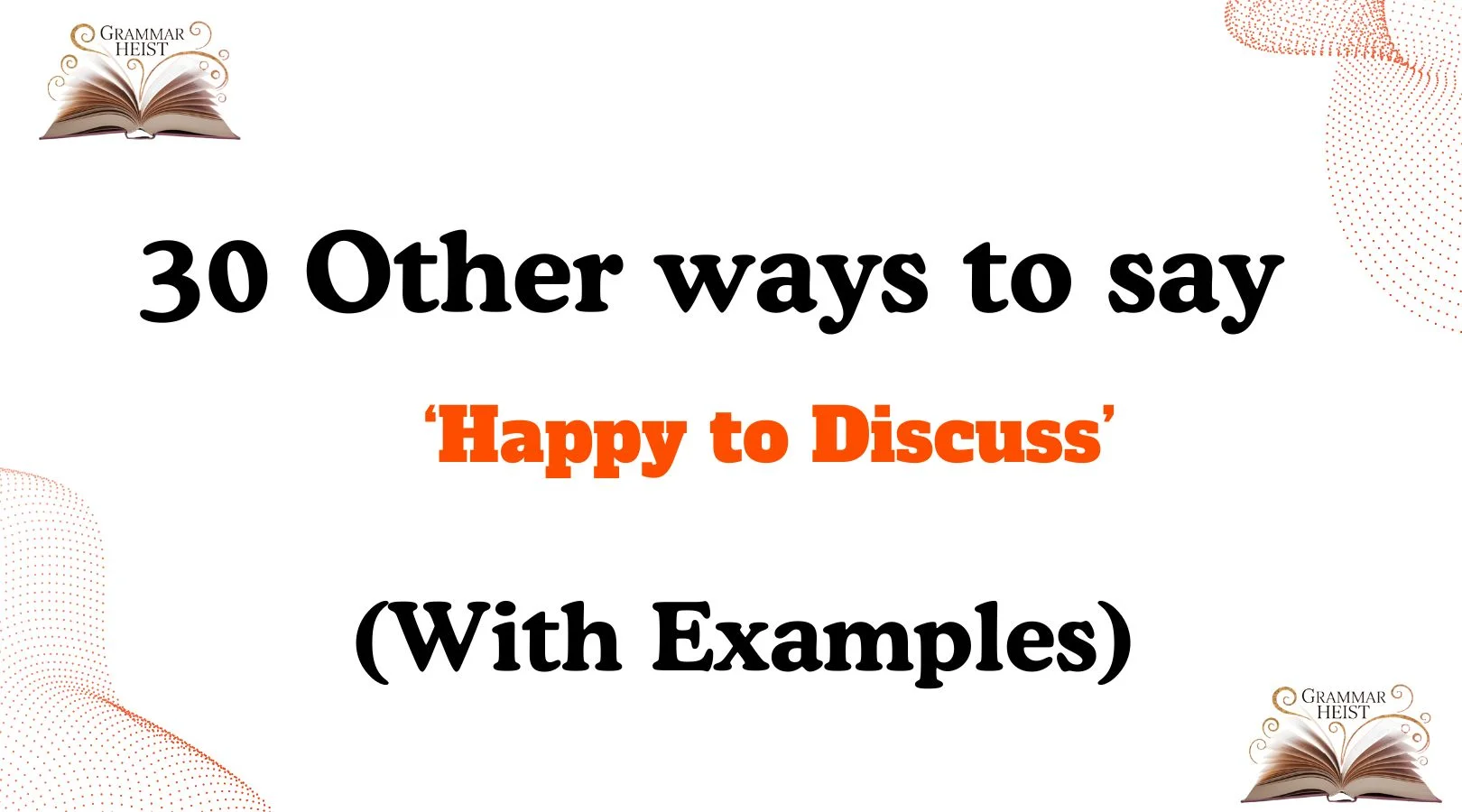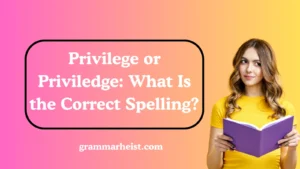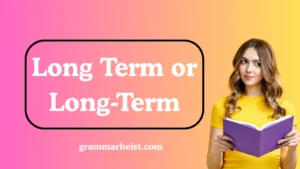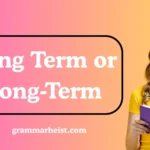Words have the power to shape how your message is received, especially in professional and personal conversations. Saying “Happy to discuss” is a warm and polite way to show openness and collaboration — but sometimes, finding fresh and more personal alternatives can make your message stand out and feel more genuine. Whether you’re writing an email, messaging a colleague, or reaching out to someone new, these 30 thoughtful alternatives will help you communicate with clarity, warmth, and confidence.
What Does “Happy to Discuss” Mean?
The phrase “Happy to discuss” simply means you’re open to talking about a topic, idea, or plan with someone else. It reflects willingness, friendliness, and a collaborative attitude. This phrase is often used in professional emails, meetings, or even casual conversations to show you’re approachable and ready to exchange ideas.
Is It Professional or Polite to Say “Happy to Discuss”?
Yes — “Happy to discuss” is both professional and polite. It creates a welcoming tone without sounding pushy or formal. However, repeating it too often can make your communication sound generic. That’s why using thoughtful alternatives can make your messages feel more personalized and engaging, especially in a professional environment.
Pros and Cons of Saying “Happy to Discuss”
Pros:
- ✅ Sounds warm and approachable
- ✅ Encourages open communication
- ✅ Fits both formal and informal settings
- ✅ Easy to understand and quick to use
Cons:
- ❌ Can feel overused or repetitive
- ❌ May lack personal touch if used too frequently
- ❌ Might sound vague in some situations
Synonyms For “Happy to Discuss”
- Open to Chat
- Glad to Talk It Over
- Happy to Chat Further
- Let’s Connect on This
- Willing to Discuss More
- Keen to Explore This Further
- More Than Happy to Talk
- Open to a Conversation
- Would Love to Discuss
- Available to Talk Anytime
- Happy to Jump on a Call
- Excited to Chat About This
- Looking Forward to the Discussion
- Open to Hearing Your Thoughts
- Always Open to a Chat
- Glad to Go Over This
- Eager to Talk About It
- Happy to Dive Into This
- More Than Willing to Chat
- Let’s Talk This Through
- Happy to Walk You Through It
- Available to Discuss Anytime
- Glad to Exchange Ideas
- Would Be Happy to Talk
- Always Here to Talk
- Let’s Touch Base
- Happy to Collaborate
- Open to Brainstorming Together
- Let’s Have a Conversation
- Happy to Answer Any Questions
1. “Open to Chat”
Scenario: Perfect for casual or friendly work settings.
Examples:
- “I’m open to chat whenever you have a moment.”
- “Totally open to chat about this further.”
- “If you’d like, I’m open to chat today or tomorrow.”
Tone: Friendly, approachable, and relaxed.
Explanation: This phrase feels natural and conversational, ideal for quick discussions or brainstorming sessions.
2. “Glad to Talk It Over”
Scenario: Ideal when showing enthusiasm and positivity.
Examples:
- “I’d be glad to talk it over and hear your thoughts.”
- “Glad to talk it over if that helps.”
- “Anytime works — I’m glad to talk it over.”
Tone: Warm and encouraging.
Explanation: This version emphasizes willingness to collaborate and ensures the other person feels heard.
3. “Happy to Chat Further”
Scenario: Suitable when continuing a conversation after an initial exchange.
Examples:
- “I’m happy to chat further if needed.”
- “Happy to chat further and clear things up.”
- “Let’s set up a time — happy to chat further.”
Tone: Open, cooperative.
Explanation: Shows genuine interest in continuing the discussion without pressure.
4. “Let’s Connect on This”
Scenario: Great for professional emails or networking.
Examples:
- “Let’s connect on this later this week.”
- “I’d love to connect on this soon.”
- “Let’s connect on this to align our ideas.”
Tone: Polished and proactive.
Explanation: Makes the conversation feel mutual, not one-sided.
5. “Willing to Discuss More”
Scenario: Best for formal or polite communication.
Examples:
- “I’m willing to discuss more if needed.”
- “Willing to discuss more at your convenience.”
- “Should you wish, I’m willing to discuss more.”
Tone: Respectful, formal.
Explanation: Shows respect for the other person’s time while keeping the door open.
6. “Keen to Explore This Further”
Scenario: When you want to express strong interest or enthusiasm.
Examples:
- “I’m keen to explore this further with the team.”
- “Keen to explore this further and find solutions.”
- “I’m genuinely keen to explore this further.”
Tone: Energetic, enthusiastic.
Explanation: Ideal when you want to convey excitement and curiosity.
7. “More Than Happy to Talk”
Scenario: Perfect for emphasizing openness.
Examples:
- “I’m more than happy to talk about this.”
- “More than happy to talk whenever suits you.”
- “Please know I’m more than happy to talk.”
Tone: Warm, enthusiastic.
Explanation: Adds a layer of friendliness that makes your message approachable.
8. “Open to a Conversation”
Scenario: Neutral and suitable for any setting.
Examples:
- “I’m open to a conversation on this.”
- “Open to a conversation when you are.”
- “Always open to a conversation.”
Tone: Balanced, neutral.
Explanation: Keeps the tone polite and inviting without sounding too casual.
9. “Would Love to Discuss”
Scenario: Good for showing eagerness or interest.
Examples:
- “I would love to discuss this further.”
- “Would love to discuss and hear your input.”
- “I’d love to discuss more when you’re free.”
Tone: Positive, warm.
Explanation: Expresses personal engagement and makes the message sound sincere.
10. “Available to Talk Anytime”
Scenario: When you want to sound flexible and open.
Examples:
- “I’m available to talk anytime that works for you.”
- “Available to talk anytime this week.”
- “Please reach out — I’m available to talk anytime.”
Tone: Friendly, accommodating.
Explanation: Shows flexibility and willingness to adjust to their schedule.
11. “Happy to Jump on a Call”
Scenario: When suggesting a real-time conversation.
Examples:
- “I’m happy to jump on a call and go over the details.”
- “Happy to jump on a call if that’s easier.”
- “Let me know — happy to jump on a call.”
Tone: Practical, approachable.
Explanation: Best for quick discussions and problem-solving.
12. “Excited to Chat About This”
Scenario: Ideal when expressing genuine enthusiasm.
Examples:
- “I’m excited to chat about this idea.”
- “Excited to chat about this and see where it goes.”
- “I’m truly excited to chat about this more.”
Tone: Cheerful, optimistic.
Explanation: Conveys passion and engagement, great for creative discussions.
13. “Looking Forward to the Discussion”
Scenario: Perfect for formal meetings or planned conversations.
Examples:
- “Looking forward to the discussion tomorrow.”
- “I’m looking forward to the discussion.”
- “Looking forward to the discussion and next steps.”
Tone: Polite, anticipatory.
Explanation: Shows professional courtesy and eagerness.
14. “Open to Hearing Your Thoughts”
Scenario: Great when you want to highlight collaboration.
Examples:
- “I’m open to hearing your thoughts on this.”
- “Open to hearing your thoughts whenever you’re ready.”
- “Looking forward to hearing your input.”
Tone: Collaborative, respectful.
Explanation: Encourages two-way communication.
15. “Always Open to a Chat”
Scenario: When emphasizing ongoing openness.
Examples:
- “I’m always open to a chat.”
- “Always open to a chat whenever works for you.”
- “Feel free to reach out — always open to a chat.”
Tone: Friendly, easygoing.
Explanation: Builds trust and approachability.
16. “Glad to Go Over This”
Scenario: Perfect for clarifying details or reviewing plans.
Examples:
- “I’d be glad to go over this with you.”
- “Glad to go over this and make sure we’re aligned.”
- “Happy to help — glad to go over this.”
Tone: Supportive, cooperative.
Explanation: Highlights willingness to help and clarify.
17. “Eager to Talk About It”
Scenario: When you want to sound proactive.
Examples:
- “I’m eager to talk about it soon.”
- “Eager to talk about it and share some ideas.”
- “Truly eager to talk about it.”
Tone: Energetic, motivated.
Explanation: Works well when you want to drive momentum.
18. “Happy to Dive Into This”
Scenario: Ideal when showing enthusiasm to engage deeply.
Examples:
- “I’m happy to dive into this topic.”
- “Happy to dive into this further.”
- “Excited to dive into this whenever works for you.”
Tone: Enthusiastic, engaged.
Explanation: Expresses readiness to explore or problem-solve.
Read More:30 Other Ways to Say ‘Just to Confirm’ (With Examples)
19. “More Than Willing to Chat”
Scenario: Emphasizes openness and support.
Examples:
- “I’m more than willing to chat.”
- “More than willing to chat if that helps.”
- “Happy to — more than willing to chat.”
Tone: Reassuring, warm.
Explanation: Strengthens the personal touch of your offer.
20. “Let’s Talk This Through”
Scenario: When wanting to solve something together.
Examples:
- “Let’s talk this through and find a solution.”
- “Happy to — let’s talk this through.”
- “Let’s talk this through to get clarity.”
Tone: Collaborative, solution-focused.
Explanation: Ideal for team problem-solving.
21. “Happy to Walk You Through It”
Scenario: Perfect for explanations or clarifications.
Examples:
- “I’m happy to walk you through it step by step.”
- “Happy to walk you through it if needed.”
- “Let me know — happy to walk you through it.”
Tone: Supportive, friendly.
Explanation: Shows helpfulness and patience.
22. “Available to Discuss Anytime”
Scenario: Ideal for keeping communication flexible.
Examples:
- “I’m available to discuss anytime.”
- “Available to discuss anytime you’re free.”
- “Reach out — I’m available to discuss anytime.”
Tone: Open, approachable.
Explanation: Highlights accessibility and willingness.
23. “Glad to Exchange Ideas”
Scenario: When you want to encourage creativity and collaboration.
Examples:
- “I’m glad to exchange ideas on this.”
- “Glad to exchange ideas and hear your thoughts.”
- “Let’s connect — glad to exchange ideas.”
Tone: Creative, warm.
Explanation: Great for brainstorming sessions.
24. “Would Be Happy to Talk”
Scenario: Neutral and polite.
Examples:
- “I’d be happy to talk about this further.”
- “Would be happy to talk whenever suits you.”
- “Happy to — would be happy to talk.”
Tone: Professional, warm.
Explanation: Works well in both formal and informal contexts.
25. “Always Here to Talk”
Scenario: When you want to sound approachable and caring.
Examples:
- “I’m always here to talk if you need.”
- “Always here to talk — no pressure.”
- “You can count on me — always here to talk.”
Tone: Reassuring, supportive.
Explanation: Creates a safe, open space for communication.
26. “Let’s Touch Base”
Scenario: Ideal for quick check-ins or follow-ups.
Examples:
- “Let’s touch base tomorrow.”
- “I’d love to touch base on this soon.”
- “Let’s touch base and realign.”
Tone: Professional, concise.
Explanation: Common in business communication.
27. “Happy to Collaborate”
Scenario: Emphasizes teamwork and partnership.
Examples:
- “I’m happy to collaborate on this project.”
- “Happy to collaborate and share ideas.”
- “Always happy to collaborate.”
Tone: Team-oriented, positive.
Explanation: Shows you’re committed to teamwork.
28. “Open to Brainstorming Together”
Scenario: Perfect for creative or strategy sessions.
Examples:
- “I’m open to brainstorming together.”
- “Open to brainstorming and seeing where it goes.”
- “Would love to brainstorm together.”
Tone: Energetic, collaborative.
Explanation: Encourages idea-sharing and innovation.
29. “Let’s Have a Conversation”
Scenario: Simple and universal.
Examples:
- “Let’s have a conversation about this soon.”
- “I’d love to have a conversation when you’re free.”
- “Let’s have a conversation and move forward.”
Tone: Direct, open.
Explanation: Keeps the message clear and human.
30. “Happy to Answer Any Questions”
Scenario: Great for support or clarification.
Examples:
- “I’m happy to answer any questions you have.”
- “Happy to answer any questions or concerns.”
- “Feel free to ask — happy to answer any questions.”
Tone: Helpful, supportive.
Explanation: Creates a safe space for open dialogue.
📝 Conclusion
Finding the right alternative to “Happy to discuss” can transform your communication. Each of these 30 phrases allows you to express approachability, warmth, and professionalism in different tones — from casual chats to formal meetings. Using varied language not only makes your message more personal but also shows thoughtfulness and respect for the person you’re communicating with.

Emma Rose is a dedicated writing expert with a passion for helping others enhance their communication skills. With a strong background in grammar, language structure, and style, Emma empowers individuals to write with clarity, confidence, and impact. Her approach combines a keen attention to detail with a supportive, personalized touch, ensuring each person she works with improves and grows in their writing journey.













